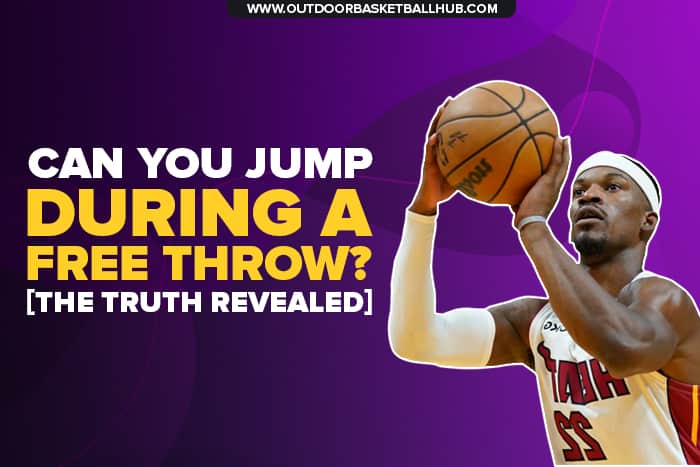- The Jump Manual Review By A Pro Player [Bonus Included] - September 23, 2023
- 3 Best Basketball Shoes For Casual Wear [September 2023] - September 3, 2023
- 5 Best Basketball Shoes For Jumping [September 2023] - August 25, 2023
When we first started hooping as young players hoping to be the next LeBron, Kobe, or MJ, it was pretty much no-holds-barred, everyone-for-themselves basketball. Yes, there’s a lot of diving, running, wrestling for the ball, and jumping; you may have even found yourself jumping from the stripe.
Quick answer: Yes, you can jump during a free throw if you don’t cross the foul line.
But as we all got older, we saw the NBA superstars of our generations performing stationary free throws with both feet firmly planted on the ground. This begged the question: can you jump during a free throw?
In short, yes, you can jump from the free throw line. That said, I’m here to show you just why you shouldn’t and how jumping from the stripe can negatively affect your shot’s repeatability and success. All based on my professional experience on the basketball court.
Let’s dive in!
Contents
Can You Jump During A Free Throw?
Officially, yes, you can jump during a free throw, so long as you’re not crossing the foul line. But it’s a bit more complicated than that. That’s why I recorded a short video answering the question in more detail and giving advice based on years of professional experience on the basketball court.
What Is A Free Throw?
A free throw is when a player is awarded an opportunity to score points without any defensive pressure from the opposing team.
Free throws are awarded by officials after a foul has been committed; the typical subseries of play that you can expect is as follows:
- Positioning—If you’re the player taking the free throw, stand behind the free-throw line
- Preparation—Whatever superstitions and routines you need to follow to ready yourself for your shot(s), you can do so long as you don’t cross the free throw line
- Shooting—You have ten seconds to release your shot, and it must go through the hoop. If it’s an airball, or you brick it, and you have been awarded two or more shots, the play is considered dead
- Scoring—If your shot is successful, your team earns one point. If your shot misses, play continues as normal; defense can rebound the ball after or if your final, awarded free throw attempt misses.
- Substitution—The player who was fouled may be substituted with another player after the free throw has been taken. A substitute free throw shooter can only check in for the player awarded the shot if they’re an injured player or if they’ve fouled out/been ejected from the game.
Where Free Throws Take Place?
As I hinted at above, you’ll be shooting from a free throw line extended 15 feet from the basket, parallel with the end lines.
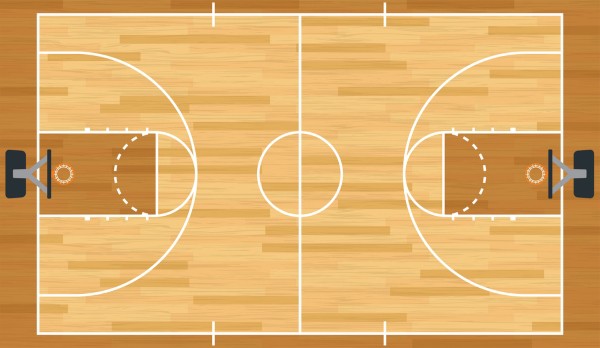
This section is just beyond the center circle, while also being ahead of the arch (also known as the “charity stripe”).
Why Are Free Throws Essential To The Game?
Free throws are a crucial part of basketball because it adds a whole another element of strategy and skill-based mechanics to the game.
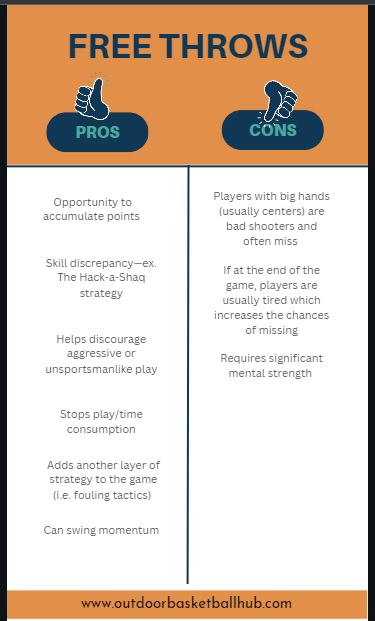
Free Throw Pros
- Opportunity to accumulate points
- Skill discrepancy—ex. The Hack-a-Shaq strategy
- Helps discourage aggressive or unsportsmanlike play
- Stops play/time consumption
- Can swing momentum
- Adds another layer of strategy to the game (i.e. fouling tactics)
Penalties
With free throws, penalizing player infractions on the court can do one of two things: a foul can help even the playing field, while also helping discourage players from competing too physically.
If you commit a personal foul, play is halted to avoid long scrambles for the ball or unfair play, helping maintain the flow of the game while adhering to the rules.
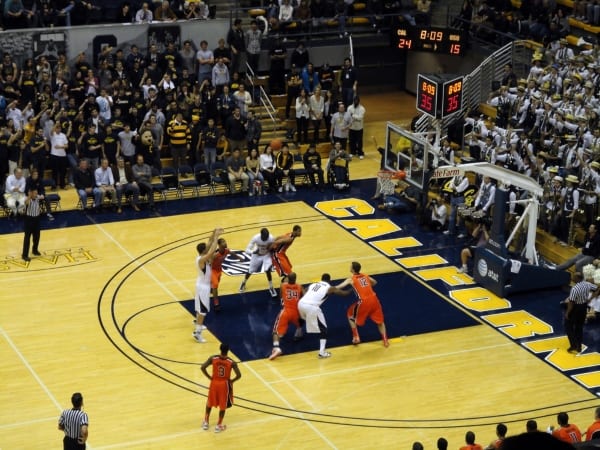
Personal fouls are a means of controlling physical contact between players and promoting fair play.
Examples Of Personal Fouls
- Charging
- Reach-In’s
- Illegal Screens
- Goaltending
For technical fouls, on the other hand, players or coaches display some sort of unsportsmanlike conduct or violate rules that are not related to live play.
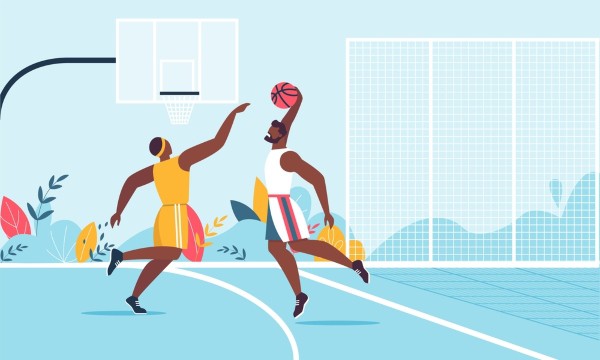
By giving the fouled team an opportunity to score from the free throw line, the rules of the game help discourage breaching the code of conduct.
Examples Of Technical Fouls
- Arguing with officials
- Abusive language
- Fighting
- Taunting
Strategy
Free throws, next to enforcing basketball’s rules and player ethics, provide another layer to basketball’s strategy and a way to get ahead of your opponent.
In an already dense, highly competitive sport that incorporates a thorough system of rules and regulations, the basketball free throw provides even more tension to the nail-biting photo-finish of a close contest.
Points
Teams that are efficient from the free throw line can use free throws to their advantage to build a lead or to close a deficit.
What’s more, players can intentionally miss free throws, adding an element of chance and suspense to the game. A great example comes from Luka from the 2023 season, where the Mavs were down by 3 points, but the 6’7” guard only had one shot left from the stripe.
Fouling Tactics
Teams may intentionally foul an opponent in order to stop the clock or prevent a basket. In these situations, the team that was fouled is awarded free throws, which can impact the outcome of the game and make an already cushioned lead feel insurmountable.
Momentum
Making a string of free throws can build momentum and deflate the opposing team. Whether home or away, momentum is a huge contributor to how effective you and your team will be on the court.
Coming In Clutch
Shooting free throws is often essential in clutch situations; when a game is tied or when there’s a small lead and time is running out, hitting your free throws successfully is a must. Teams that are confident and efficient from the free-throw line can use this to their advantage in these situations.

At the college level, any hooper shooting above 75% from the free throw line has what’s considered an effective conversion rate. Meanwhile, playing at the highest level, Steph Curry has, undoubtedly, the highest free throw percentage in the NBA, sitting at over 90%.
In a game where every bucket matters and a game can come down to single-digit dubs, or even with free throw shots at less than a second left, a clutch, effective free throw can make all the difference and win you the game. That’s why coaches value basketball players who can skillfully shoot free throws.
Why Jump During A Free Throw?
Some players may feel the need to jump when shooting free throws because of limited success from the stripe, either because they are younger athletes or from a lack of confidence. In basketball, jumping during a free throw, while there’s nothing directly in the rule book stating you can’t, is generally frowned upon.
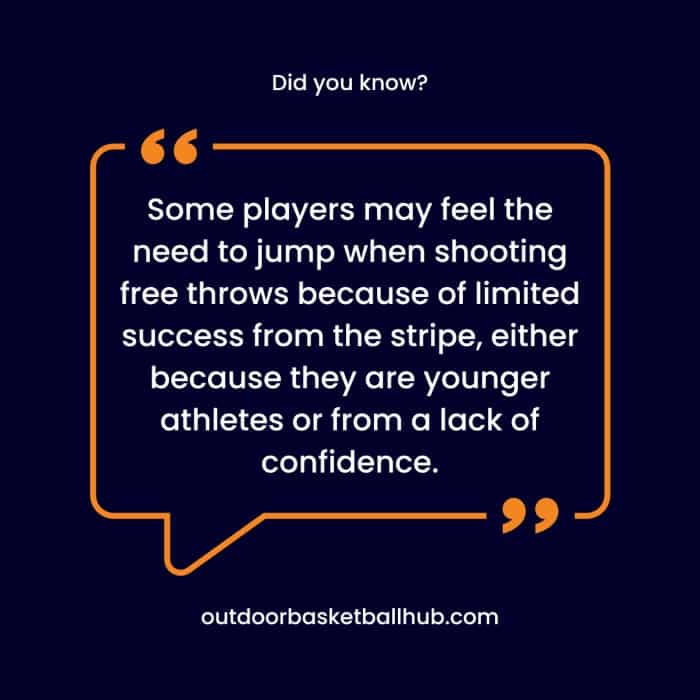
A stationary set shot at the line is intended to provide a consistent and fair shooting motion for all players with enough power to deliver. This form also prevents most players with height advantages from increasing their height or reach to the basket.
Notable NBA Players Who Jumped During A Free Throw
There have been a handful of instances involving NBA players where the shot has been attempted via a normal jump shot or even a lob/alley-oop. Let’s bring it back to Shaquille O’Neal at the 2006 All-Star game:
On that note, players like Wilt Chamberlain, one of the best in NBA history (with an explosive vertical jump), standing at a massive 7’1″, didn’t have to shoot free throws; he had enough reach to dunk free throws from the line. Still, shooting free throws was one of his many strong skills.
That said, some players such as Dwight Howard struggle with their free throws.
When You’ll Be Jumping During Free Throws Shots?
If you are jumping during your free throw shot while on offense, you’re more than likely playing in a casual game with light competition among friends who don’t take the game too seriously. Inversely, it’s because you’re inefficient when shooting free throws and require a little extra boost to secure a basket. Sure enough, to jump higher, you need appropriate shoes for jumping.
How To Shoot A Free Throw
Every player shoots differently, and with the fundamentals in your back pocket, your form will depend on things like flexibility, strength, previous injuries, fatigue, etc. With that in mind, here are some tips and tricks for landing a successful free throw from the charity stripe.
Free Throw Do’s
Here’s what’s recommended to do when you shoot free throws:
- Follow Through—helps guide the ball through the net
- Balance—keep your weight centered and feet shoulder-width apart for added stability
- Stepping—crossing the stripe results in a penalty, and no points are awarded
- S.E.D.R.S—shoot from your dominant eye
- Alignment—keep your shoulders and hips aligned with the rim
- Concentrate—many hoopers take 3 dribbles to mark 3 seconds of concentration (i.e. take your time)
What’s widely considered good form and proper hand placement for the best free throw is:
- Grip the ball with your shooting hand: the ball should sit comfortably in the palm of your hand, with your fingers spread evenly around the ball and by the seams.
- Place your non-shooting hand (or guide hand) on the side of the ball: Your non-shooting hand should be used to balance the ball and guide it through the basket; don’t think of it as applying extra force.
- Align your shooting hand with the rim: the center of your basketball should be directly in line with the center of the rim, with your shooting hand positioned just under the ball.
- Extend your arm straight: Keep your arm extended straight towards the basket, with your elbow slightly bent, and the ball positioned directly above your shooting eye.
A recent study by Polish scholars suggested that for achieving high-free throw effectiveness, advanced basketball players compensate their coordination structures from proximal to distal.
A distal structure is farther away from the center of the body where, in this case, players control their free throws from the legs and hand placement. This also shows just how a hooper’s body and automatic bodily responses change when stepping to the line.
Free Throw Don’ts
And here’s what to avoid doing when you shoot free throws:
- Never cross the free throw line, or you will get penalized for it. Here’s the official nba rule.
- Don’t jump if you think that your physical strength is more than enough to help the ball perfectly reach the rim.
- Don’t try to dunk during a free throw because that increases your chances of crossing the throw line.
Practice Makes Perfect
Continue to practice, practice, practice; the more time you put into the gym, the more effective you’ll be on the court, and the more those conscious efforts start to convert to muscle memory.
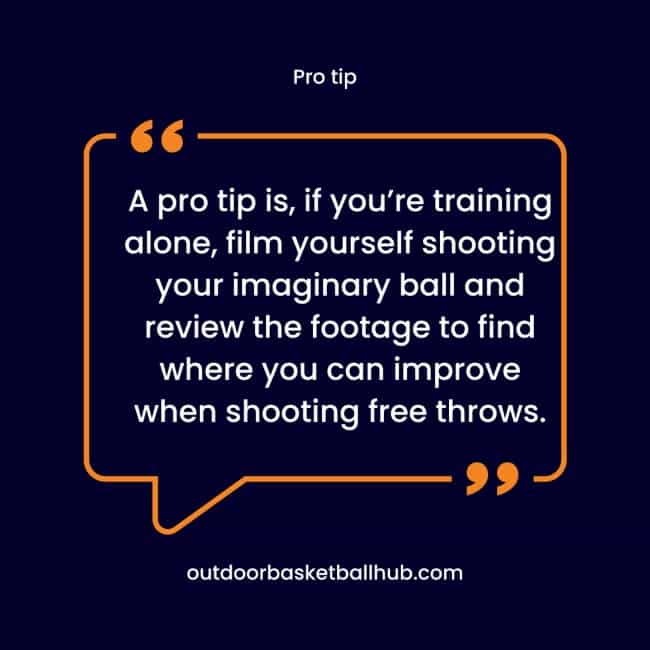
You can always apply the “Steve Nash Hack” when training: shoot free throws without using a basketball to focus on the proper form, alignment, and hand-positioning.
A pro tip is, if you’re training alone, film yourself shooting your imaginary ball and review the footage to find where you can improve when shooting free throws.
How To Shoot Without Jumping
Free throws, like a lot of the mechanics of the game, boil down to muscle memory. Therefore, if you’re looking to shoot your and-1 chance without jumping, you’ll need to practice the right way so as to not develop any bad habits.
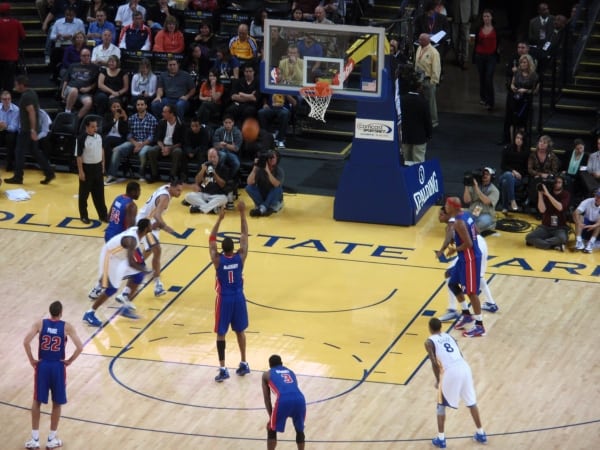
To shoot a free throw standing, keep your weight centered with a low center of gravity: you’ll be driving from your legs while keeping them evenly distributed and fixed in place. Your legs will be the source of your power.
From there, follow the proper shooting mechanics, and you’ll be draining free throws in no time. Remember that when you shoot free throws.
Why You Shouldn’t Jump
Jumping while shooting free throws will, ultimately, affect your consistency.
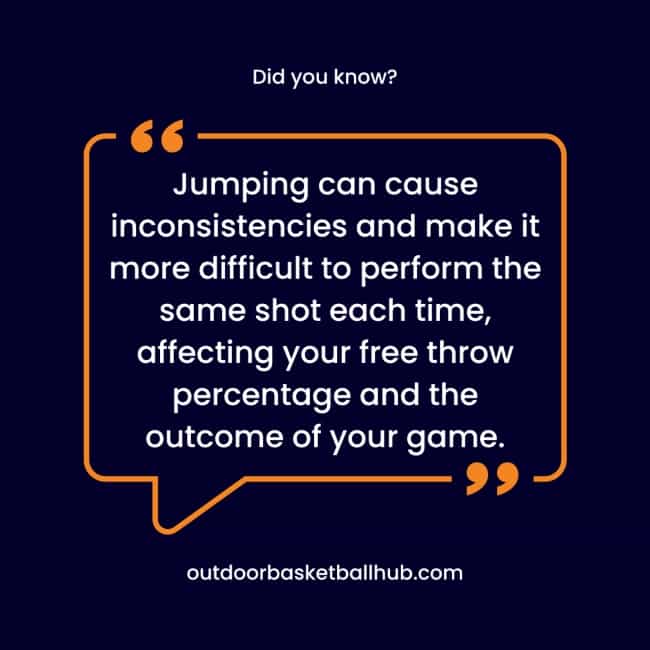
Free throws are meant to be a controlled, repetitive motion. Jumping can cause inconsistencies and make it more difficult to perform the same shot each time, affecting your free throw percentage and the outcome of your game.
There’s a reason why everyone from high school varsity to the pros refrain from jumping during their free throw shots.
At the same time, jumping while shooting a free throw can cause you to accidentally jump over the line; this is strictly prohibited in an organized game, resulting in play being called dead and any point earned during the free throw chance being invalidated.
FAQ
You can’t jump during a free throw because it opens up more chances to miss your shot based on jump inconsistencies or your points being invalidated because you stepped over the line. A free throw is meant to have a sustainable, consistent motion that can be repeated and controlled, which is why most players prefer not to jump. This helps ensure the best possible chance of a conversion.
You aren’t allowed to jump over the line on a free throw. The charity stripe can’t be crossed until the ball touches the rim, backboard, or has gone through the net. A player must have their feet completely behind the line in order to ensure the integrity of the free throw as a stationary shot, as well as in not giving the shooting team an advantage.
The rules for free throws depend on the penalty given to the defense. For technical fouls, two shots are awarded while the offending team loses possession of the ball. For personal fouls and/or and-1 chances, two shots or one shot is allocated to the shooting team. Players must shoot from behind the stripe, and you have 10 seconds to shoot once you’ve been given the ball by officials.
You can’t dunk on a free throw. Dunking is a high-flying, explosive shot typically done during live play, not during free throws. Basketball leagues prohibit dunking during extra point chances because it goes against the nature and purpose of a free throw, which is meant to be a stationary shot.

